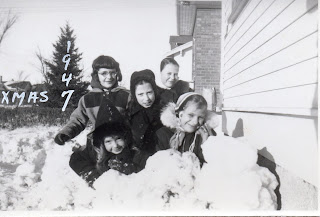The House of the Hanged Man was painted by Cezanne in 1873 and
depicts a picturesque cottage situated in Auvers near the Rue de Four.
Despite the title, no suicide or hanging is known to have taken place there.
Supposedly, the house had been owned by a Breton man named Penn’Du, which closely
sounds like the French word for hanged man - Pendu.
I read of this painting on Vivian Swift's blog which I read weekly; and the title suited the dark side of humanity I was wading into at the time. While researching the Winnipeg Police Department's buffalo robe coats I stumbled on information about the last person hanged in Headingley Jail in Manitoba. What caught my attention was the fact that the hangman got a credit. His name was Camille - he was wearing a black beret and a Hawaiian shirt. Wardrobe surprise! Wouldn't you think a serious job like hanging people would call for a somber costume...a black shirt perhaps? The beret befuddled me completely. I cannot imagine why someone would dress like this to perform a hanging, but then I know no one who would take such a job.
And so I did a little more Wikipedia research and learned that Canada's "official" hangmen have been few - only three of them:
1. J Radcliffe was hired as Canada’s national hangman in 1892. One of the original stipulations in his contract with the federal government included a clause that might seem odd today, but was apparently the norm for many hangmen of that time around the world — Radcliffe was entitled to the clothes off the backs of the men he executed.
Radcliffe, sometimes spelled “Radclive”, also liked to sell lengths of rope as souvenirs as he travelled the country performing executions. The fact was, the rope used in the hangings themselves was never passed on to the hangmen. Radcliffe was once caught in a B.C. hardware store by a local sheriff; the hangman was buying extra rope. Presumably he sold lengths as "the piece of rope that hanged so-and-so".
He was British, but lived in Toronto and worked on the side as a waiter at a yacht club; he was fired when a customer recognized him from his other line of work. At the time of Radcliffe’s death, it was reported he had hanged upwards of 150 people.
2. Arthur Ellis. Arthur Ellis was the pseudonym of Arthur B. English, a British man who became Canada's official hangman in 1913, after Radclive's death. Ellis worked as a hangman in Canada until the botched execution of Thomasina Sarao in Montreal in 1935, in which she was decapitated.
He died in poverty in Montreal in July, 1938. Ellis is prominently featured in the 2009 documentary
"Hangman's Graveyard".
This is as close to a hangman as I've ever been. Close enough for me.
I read of this painting on Vivian Swift's blog which I read weekly; and the title suited the dark side of humanity I was wading into at the time. While researching the Winnipeg Police Department's buffalo robe coats I stumbled on information about the last person hanged in Headingley Jail in Manitoba. What caught my attention was the fact that the hangman got a credit. His name was Camille - he was wearing a black beret and a Hawaiian shirt. Wardrobe surprise! Wouldn't you think a serious job like hanging people would call for a somber costume...a black shirt perhaps? The beret befuddled me completely. I cannot imagine why someone would dress like this to perform a hanging, but then I know no one who would take such a job.
And so I did a little more Wikipedia research and learned that Canada's "official" hangmen have been few - only three of them:
1. J Radcliffe was hired as Canada’s national hangman in 1892. One of the original stipulations in his contract with the federal government included a clause that might seem odd today, but was apparently the norm for many hangmen of that time around the world — Radcliffe was entitled to the clothes off the backs of the men he executed.
Radcliffe, sometimes spelled “Radclive”, also liked to sell lengths of rope as souvenirs as he travelled the country performing executions. The fact was, the rope used in the hangings themselves was never passed on to the hangmen. Radcliffe was once caught in a B.C. hardware store by a local sheriff; the hangman was buying extra rope. Presumably he sold lengths as "the piece of rope that hanged so-and-so".
He was British, but lived in Toronto and worked on the side as a waiter at a yacht club; he was fired when a customer recognized him from his other line of work. At the time of Radcliffe’s death, it was reported he had hanged upwards of 150 people.
2. Arthur Ellis. Arthur Ellis was the pseudonym of Arthur B. English, a British man who became Canada's official hangman in 1913, after Radclive's death. Ellis worked as a hangman in Canada until the botched execution of Thomasina Sarao in Montreal in 1935, in which she was decapitated.
He died in poverty in Montreal in July, 1938. Ellis is prominently featured in the 2009 documentary
"Hangman's Graveyard".



























